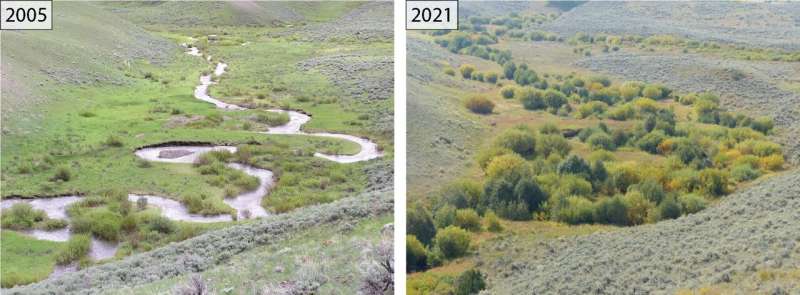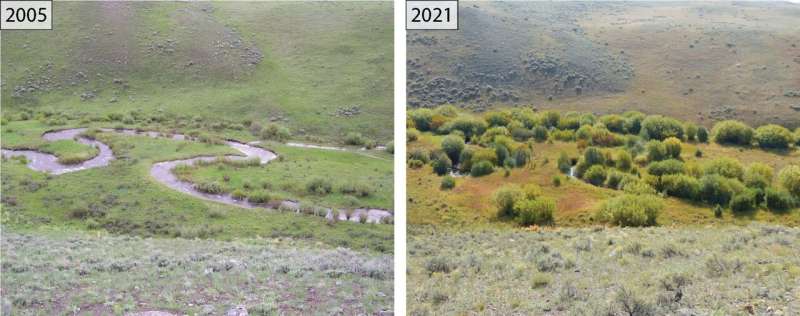New research has demonstrated the powerful impacts the reintroduction of predators can have on an ecosystem. The presence of wolves in Yellowstone National Park has driven a cascading effect that has literally changed the landscape.
ADVERTISEMENT GO AD FREE
The new study used data from previous studies on 25 riparian (streamside) sites collected over a 20-year period – from 2001 to 2020. The results show a 1,500 percent increase in willow crown volume along these streams in northern Yellowstone National Park. The effects were produced by changing behavior among elk adapting to the presence of a large carnivore guild (wolves) reintroduced into the Park in 1995-96, and other factors.
This type of change is the result of a really cool phenomenon known as a trophic cascade. It’s an indirect effect predators have that extends downwards through the food web.
In this context, wolves were eradicated in Yellowstone during the 1920s and the cougar population was driven to low numbers. Over the following decades, when wolves were absent from the National Park, the elk population was able to strut around confident and safe. They therefore graze out in the open without fear of being killed, leading to less vegetation and smaller trees.
But when wolves were reintroduced in the 1990s, the predators not only reduced the elk population but also caused them to change their grazing habits – forcing them to become more cautious and avoid open environments.
This allowed the surrounding vegetation to grow, which then attracted more diverse species of birds and insects. The regrowth of plants and trees has been so powerful that it has even caused rivers to move as riverbank erosion slowed down, leading to less meandering and allowing channels to deepen and small pools to emerge. This, in turn, eventually changed the geography of the surrounding area.
The impacts of trophic cascades, therefore, have incredible influences on all aspects of the wider ecosystem, changing biodiversity, primary productivity, and even the nutrient cycle.
ADVERTISEMENT GO AD FREE
Although trophic cascades and their startling effects have been of ecological interest for some time, this new study is the first to quantify its strengths by focusing on riparian willow volume. It uses these trees as a proxy for aboveground biomass, showing a distinct and significant three-dimensional recovery of streamside vegetation measured by the growth of both crown area and height among the willows.

Trophic cascades are so powerful that they can transform a landscape in a short period of time.
The strength of the Yellowstone trophic cascade observed in this study surpasses 82 percent of strengths presented in a synthesis of global trophic cascade studies, demonstrating the significance of Yellowstone’s willow recovery process. Despite this, the authors stress that there is considerable variability in the degree of recovery, so not all sites recover at the same speed or to the same extent.
Riparian areas in the western US comprise a small portion of the landscape, but the study shows how valuable they are because they provide important food resources and habitat for more wildlife species than any other type. They also connect upland and aquatic ecosystems, having high diversity in species composition, structure, and productivity.
“Our findings emphasize the power of predators as ecosystem architects,” William Ripple said in a statement. “The restoration of wolves and other large predators has transformed parts of Yellowstone, benefiting not only willows but other woody species such as aspen, alder, and berry-producing shrubs. It’s a compelling reminder of how predators, prey, and plants are interconnected in nature.”

Contrasting photos showing the growth of vegetation at Blacktail Deer Creek in 2005 and 2021.
“Our analysis of a long-term data set simply confirmed that ecosystem recovery takes time. In the early years of this trophic cascade, plants were only beginning to grow taller after decades of suppression by elk,” Dr Robert Beschta, an emeritus professor at Oregon State University, added.
“But the strength of this recovery, as shown by the dramatic increases in willow crown volume, became increasingly apparent in subsequent years. These improving conditions have created vital habitats for birds and other species, while also enhancing other stream-side conditions.”
The study illustrates the utility of using crown volume of stream-side shrubs as a key metric for assessing trophic cascades, potentially enhancing methods for studying riparian ecosystems in other locations. It also underscores the value of predator restoration for encouraging biodiversity and ecosystem resilience.
The paper is published in Global Ecology and Conservation.
Source Link: Reintroduced Wolves Caused A "Trophic Cascade", Transforming Yellowstone's Ecosystems